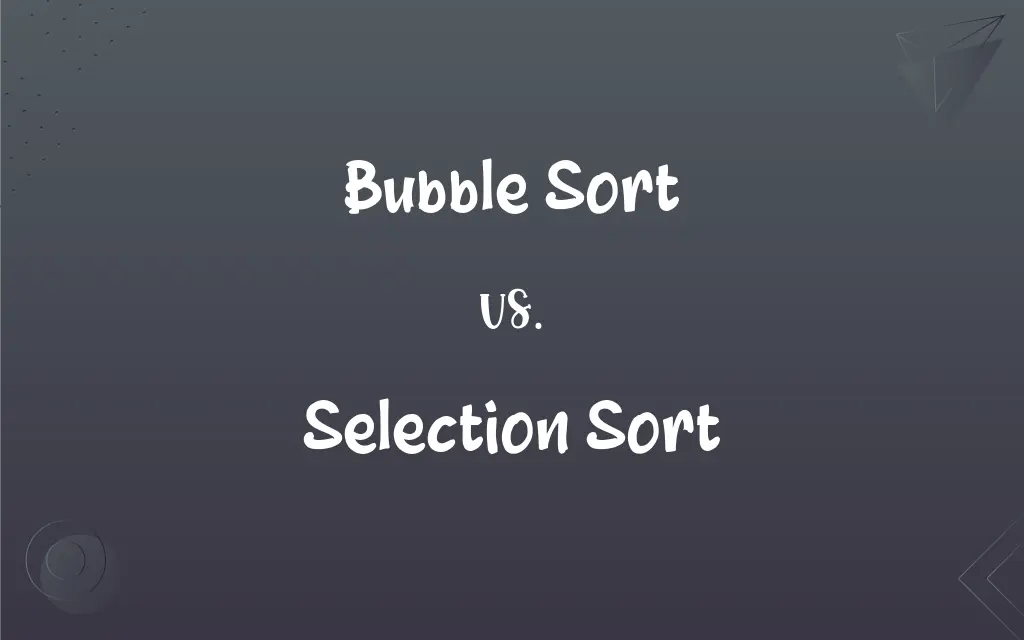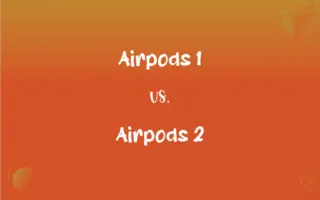Bubble Sort vs. Selection Sort: What's the Difference?
Edited by Aimie Carlson || By Janet White || Published on February 20, 2024
Bubble sort repeatedly swaps adjacent elements if they are in the wrong order, while selection sort finds the minimum element and moves it to the sorted part.

Key Differences
Bubble sort is a simple sorting algorithm that repeatedly steps through the list, compares adjacent elements, and swaps them if they are in the wrong order. Selection sort, on the other hand, works by repeatedly selecting the smallest (or largest) element from the unsorted portion of the list and moving it to the end of the sorted portion.
The main characteristic of bubble sort is its repeated comparison and swapping of adjacent elements, which gives it the name "bubble" as smaller or larger elements "bubble" to the top of the list. In contrast, selection sort's key operation is finding the minimum (or maximum) element and swapping it with the first unsorted element.
Bubble sort typically has a higher time complexity, making it less efficient for large lists compared to more advanced sorting algorithms. Selection sort, despite also having high time complexity, generally performs better than bubble sort but is still not suitable for large data sets.
Bubble sort is known for its simplicity and ease of implementation but is inefficient for large lists due to its quadratic time complexity. Selection sort is also easy to implement and has the advantage of reduced swap operations compared to bubble sort.
In bubble sort, the largest element in the list moves to its correct position after each complete iteration through the list. In selection sort, the algorithm maintains two subarrays in the given array – one subarray is already sorted, and the other subarray is unsorted.
ADVERTISEMENT
Comparison Chart
Method
Swaps adjacent elements.
Selects minimum element and moves it.
Performance
Generally slower, especially for large lists.
Performs better than bubble sort but not efficient for large lists.
Swap Operations
Higher number of swaps.
Fewer swap operations.
Best Used
On small or nearly sorted data sets.
When swap operations are more costly.
Bubble Sort and Selection Sort Definitions
Bubble Sort
Often used as an introductory sorting algorithm in education.
The programming class started with bubble sort to introduce sorting concepts.
ADVERTISEMENT
Selection Sort
A sorting algorithm that selects the smallest element from an unsorted list in each iteration and places it at the beginning.
Selection sort methodically moved the smallest elements to the start of the list.
Bubble Sort
A sorting algorithm where each pair of adjacent elements is compared and swapped if in wrong order.
Using bubble sort, the algorithm iterated through the entire list, swapping elements until fully sorted.
Selection Sort
Divides the input list into two parts: sorted and unsorted.
With each iteration, the sorted section of the array increased in selection sort.
Bubble Sort
Smaller or larger elements "bubble" to the top in each iteration.
After the first pass of bubble sort, the largest number was at the end of the list.
Selection Sort
Simplistic in nature but inefficient for large lists.
Despite its simplicity, selection sort was not fast enough for the application's needs.
Bubble Sort
Known for its simplicity but inefficiency in large datasets.
Bubble sort was chosen for its ease of understanding, despite its slower performance on large arrays.
Selection Sort
Known for reduced number of swaps compared to other sorting algorithms.
Selection sort was more efficient in terms of swap operations than other simple sorts.
Bubble Sort
Involves multiple passes through a list to sort it.
Bubble sort made several passes through the array to place all elements in order.
Selection Sort
Selection sort works by repeatedly finding the minimum element from the unsorted section and putting it at the beginning.
The selection sort algorithm continually places the next smallest element from the unsorted section at the start of the sorted section.
FAQs
How does selection sort differ from bubble sort?
Selection sort finds the minimum element in each pass and places it in the sorted part, while bubble sort repeatedly swaps adjacent elements if they are in the wrong order.
Can selection sort be used for large lists?
Selection sort is not recommended for large lists due to its quadratic time complexity, making it inefficient for large datasets.
Is bubble sort efficient for large datasets?
No, bubble sort is generally inefficient for large datasets due to its O(n²) time complexity.
What is an advantage of selection sort over bubble sort?
Selection sort performs fewer swaps compared to bubble sort, which can be advantageous in scenarios where writing to memory is a costly operation.
What are the space complexities of bubble and selection sorts?
Both bubble sort and selection sort have a space complexity of O(1), meaning they require a constant amount of extra space.
Can bubble sort be optimized?
Yes, bubble sort can be optimized by stopping the algorithm if no swaps are made during a pass, indicating the list is sorted.
What is bubble sort?
Bubble sort is a simple comparison-based sorting algorithm that repeatedly steps through the list, compares adjacent elements, and swaps them if they are in the wrong order.
Is bubble sort stable?
Yes, bubble sort is a stable sorting algorithm as it maintains the relative order of equal elements.
Do bubble and selection sorts require additional memory?
No, both algorithms are in-place sorts and do not require additional memory beyond what is needed for the list itself.
Why is selection sort not preferred for large datasets?
Because of its quadratic time complexity, making it inefficient for large datasets.
Is selection sort stable?
By default, selection sort is not stable, but it can be made stable with some modifications.
What is the best-case time complexity of bubble sort?
The best-case time complexity of bubble sort is O(n) when the list is already sorted.
Why are bubble sort and selection sort not used in practice?
Due to their quadratic time complexities, both bubble sort and selection sort are not efficient for large datasets, making them impractical compared to faster algorithms like quicksort or mergesort.
Can bubble sort be used for partially sorted arrays?
Yes, bubble sort can be efficient for arrays that are already partially sorted.
Which is faster, bubble sort or selection sort?
Generally, both have similar time complexities (O(n²)), but selection sort can be slightly faster as it makes fewer swaps.
Can selection sort be used on linked lists?
Yes, selection sort can be applied to linked lists, but its performance remains inefficient.
How do bubble and selection sorts compare in terms of swap operations?
Selection sort generally performs fewer swap operations compared to bubble sort.
What is a practical use case for bubble sort?
Bubble sort is often used in educational contexts to teach basic sorting and algorithm concepts due to its simplicity.
Are bubble sort and selection sort easy to implement?
Yes, both bubble sort and selection sort are easy to implement, making them good choices for introductory programming.
Can the efficiency of selection sort be improved significantly?
Not really, as its basic operation counts are fixed.
About Author
Written by
Janet WhiteJanet White has been an esteemed writer and blogger for Difference Wiki. Holding a Master's degree in Science and Medical Journalism from the prestigious Boston University, she has consistently demonstrated her expertise and passion for her field. When she's not immersed in her work, Janet relishes her time exercising, delving into a good book, and cherishing moments with friends and family.
Edited by
Aimie CarlsonAimie Carlson, holding a master's degree in English literature, is a fervent English language enthusiast. She lends her writing talents to Difference Wiki, a prominent website that specializes in comparisons, offering readers insightful analyses that both captivate and inform.
































































